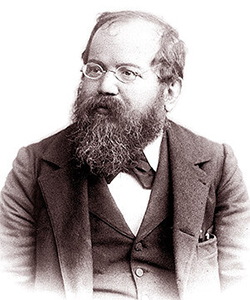By Alex Gordon


HAIFA, Israel –Wolf, later Wilhelm, and even later William Steinitz, an Austro-American chess player and the first World Chess Champion, was born in the Prague ghetto on May 14, 1836, in the family of a tailor and synagogue servant. He was the youngest of 13 children and received a traditional Jewish education.
He began to play chess seriously at the age of 20 after leaving Prague in 1857 to study mathematics at the Vienna Polytechnic Institute. Steinitz spent two years at the university. From 1862 to 1883, Steinitz lived in London and then in the United States. In 1866, he won a match against the strongest player of that time, the German chess player Adolf Andersen, the winner of the first international chess tournament in history held in London in 1851. Andersen was the most prominent representative of chess romanticism, an advocate of an aggressive, combinatorial style of play with many spectacular sacrifices of chess pieces.
In 1886, the first match in history for the title of World Chess Champion took place in the USA. Steinitz’s opponent was the strongest player of that time, Johannes Hermann Zukertort. Zukertort was a German and later British chess player, the son of a Prussian Lutheran pastor, a baptized Jew, and a missionary who spread Protestantism among the Jews. Zukertort was a student of Andersen, who surpassed his teacher and shared his vibrant, combinatorial style of play. The competitors played 20 games, resulting in 10 victories for Steinitz, 5 for Zukertort, and 5 draws. Steinitz was declared the World Champion. He held this title until 1894, when he was defeated in a match by Lasker.
The second world champion, another Jew, a doctor of mathematics, Emmanuel Lasker, commented on this match: “Zukertort believed in combinations, was gifted with creative inventiveness in this area. However, in most of the games of the match, he could not use his strength, as Steinitz seemed to have the gift of foreseeing a combination long before it appeared and, if desired, preventing its realization. […] More skilled in positional play, Steinitz outplayed his opponent, who surpassed him in combinational talent.”
Lasker summarized the new style introduced by Steinitz as follows: “At the beginning of the game, ignore the search for combinations, refrain from forced moves, strive for small advantages, accumulate them, and only after achieving these goals seek a combination – and that with all your will and intellect, because then the combination must exist, no matter how deeply it is hidden.”
In 1873, Steinitz introduced a new positional style of play and demonstrated that it surpassed the previous one. His new style sparked controversy, with some even calling it “cowardly,” but many of Steinitz’s games showed that he could organize attacks as fierce as those of the old school. Steinitz was a chess theorist, a thinker. He was not just a chess player; he was a revolutionary. In an era when chess champions played by “intuition,” he developed a new approach to the game that included strategy, defense, and structural principles. This was “scientific” chess. In the Steinitz-Zukertort match, chess realism triumphed over chess romanticism.
Besides the clash of two different approaches to chess, this match also felt like a confrontation between Steinitz, a Jew, and Zukertort, the son of a Protestant missionary who despised Jews. Zukertort told Steinitz, “You are not a chess player, you are a Jew.” Steinitz had the following explanation for the Jewish mastery of the game: “patience, pure upbringing, and a good nature. Being the most persecuted race in the world, [Jews] had the least opportunity to do harm and became the kindest of all peoples.”
Throughout his chess career, Steinitz encountered and fought against antisemitism multiple times. In connection with the expulsion of Jewish chess players from the St. Petersburg Society (Society of Lovers of the Game of Chess) in 1891, he sought clarification from the renowned Russian chess player Mikhail Chigorin, whom he had defeated in matches in 1889 and 1892. He published an indignant article in the New York Tribune about the expulsion of Jews from the Russian chess society.
In the official collection released for the Hastings tournament of 1895, Steinitz was given the following portrait: “Chess is his life and soul, the meaning of his existence. With a brilliant intellect and a rare love for the game, he can forget everything else, people and things. […] His appearance is unusual and striking: a beautiful and large head with a prominent forehead, gray hair, and a brick-colored beard, quite stout, suffering from a slight limp which has naturally worsened with age, he walks with a cane.”
The Russian chess player Evgeny Znosko-Borovsky described him like this: “Such, deeply lost in his thoughts, with a huge prominent forehead, he is depicted in the surviving portraits. However, they apparently give only a distant idea of what Steinitz was really like. This is again a canon, an iconography, before us is a philosopher, not a fighter. Meanwhile, it was enough to look into Steinitz’s eyes, extraordinarily lively, sharp, mocking, looking greedily, sometimes defiantly and provocatively, to understand that he was not an impassive thinker, but a passionate and self-loving player. It was only on the outside that he seemed like a well-mannered, calm old man: inside, a flame was boiling.”
Lasker considered Steinitz not just a chess theorist, but also a great philosopher. In 1930, the future world champion Max Euwe described Steinitz’s teachings as the foundation of chess strategy in his chess textbook.
Steinitz began working on a major work titled “Judaism in Chess,” but he did not complete it. Shortly before Steinitz’s death, his pamphlet against antisemitism was published: “My Response to the Antisemites in Vienna and Anywhere Else…”. His closest lifelong friend was the Austrian Jewish thinker and inventor Joseph Popper-Lynkeus, whose 1886 study Prince Bismarck and Antisemitism, with which Steinitz wholeheartedly agreed, predated Theodor Herzl, who proposed creating a Jewish state to save Jews from antisemitism.
When, after the rematch with Lasker, held in Moscow in 1896–1897, Steinitz fell ill with a nervous disorder and was placed in a hospital, he had the humor to demand his expulsion from Moscow as a Jew without residency rights. He hinted at the expulsion of Jews in 1891: on the Passover of 1891, Tsar Alexander III signed an order expelling most of the Jews from the city.
Steinitz died in New York on August 12, 1900, at the age of 64, but antisemites did not leave him (and his spiritual successor Lasker) in peace even after his death. On March 18-23, 1941, two months after Lasker’s death, the then-fourth World Chess Champion, Russian émigré Alexander Alekhine, attributed malicious ideas to Jewish chess players in a series of articles titled Aryan and Jewish Chess, published in German in Germany and Nazi-occupied France and the Netherlands in the newspapers Pariser Zeitung and Die Deutsche Zeitung in den Niederlanden.
At the Munich European Chess Tournament in September 1941, in which Alekhine participated as a representative of Vichy France, his table was adorned with a swastika flag. Alekhine wrote: “Are Jews a nation particularly talented in chess? Having thirty years of experience behind me, I dare to answer this question as follows: yes, Jews possess the highest abilities to use their intellect and practical acumen in chess. But a Jew who would be a true artist in chess has never existed.”
Alekhine criticizes one of the followers of Steinitz and Lasker, the Riga grandmaster Aaron Nimzowitsch, a Jew, using racist terminology: “1) his idea of ‘maneuvering’ is nothing more than a variation of the already known waiting for the opponent’s mistake according to Steinitz and Lasker; 2) the idea of ‘overprotection’ (premature protection of supposedly weak points), again purely Jewish, hinders the spirit of struggle. In other words, fear of struggle! Doubt in one’s own mental abilities – truly a sad picture of intellectual decline!”
Alekhine argued that all Jewish chess players are opportunists who could never and will never be able to oppose Aryan masters of the game. He considered such masters to be the Russian Mikhail Chigorin and the Cuban José Raúl Capablanca.
After the defeat of the Nazis, Alekhine faced the threat of being banned from tournaments and stripped of his title as world champion. He defended himself, claiming that he did not write those articles, but his fourth and last wife, the Englishwoman Grace, showed the text of Aryan and Jewish Chess, written in her husband’s handwriting. Alekhine died on March 24, 1946, an undefeated but disgraced world chess champion.
Upon learning of Steinitz’s death, his conqueror Lasker bitterly remarked: “Steinitz was a thinker worthy of a university chair. He was not a player: he was too profound for that. He was defeated by a player, and died little appreciated by the world.”
*
Alex Gordon is professor emeritus of physics at the University of Haifa and at Oranim, the Academic College of Education, and the author of 11 books.